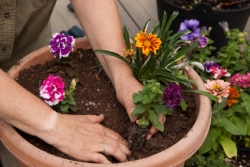![]() Prices in Canadian Dollars.
Prices in Canadian Dollars.![]() Prefer to call and speak to a floral agent? 1-877-277-4787
Prefer to call and speak to a floral agent? 1-877-277-4787
Annual Garden Plants
Annual Garden Plants
An annual plant (often referred to as simply an annual) is a plant that usually germinates, flowers, and dies in a single year or season, true annuals will only live longer than a year if they are prevented from seeding.
In your garden, the term annual often refers to plants that grow in the spring and summer and survive for just one growing season. There are many plants used as annuals in northern climates that are in fact perennial if planted far enough south where they do not experience the damaging effects of frost. These include such plants as geranium, impatiens, vinca, coleus, and lantana.
Although requiring replanting for every growing season, annuals provide the gardener with a new opportunity every year (or even throughout a single growing season) to change the look of an entire garden or select parts of it. They grow quickly, are easy to maintain, and can provide a carpet of color that instantly transforms a garden into something new. Gardening with annuals allows you the freedom to exercise your creativity and revamp your color scheme every season. You can experiment with all the new varieties the hybridizers develop each year.
Gardening with Annuals
Annuals
Before you plant annuals in your garden, you’ll want to actually sketch out a basic garden plan. Simply throwing down seeds or planting bedding plants randomly seldom provides a desired result. More often than not, this approach will produce unsatisfactory results. Draw a quick outline of your garden bed, noting down its approximate dimensions and the amount of sun the area receives each day, and your thoughts about preferred height in specific areas (L=Low, I=intermediate, T=Tall, V=Vine (where you have something for it to attach to , trellis, fences, etc). Also at this point it is a great idea to give some thought towards colour, using coloured pencils to designate areas on your garden plan will help with this.
Selecting Annual Varieties
One of the kes to a great looking and successful annual garden is properly selecting the right varieties at the beginning. Annuals that share similar light, water and fertility requirements make better, healthier neighbors.
Color – Use colors that complement each other and your home and yard. Colors are either warm or cool, depending upon the hue, Red and yellow are warm. White, blue and violet are cooler. Complementary colors (violet and yellow, blue and orange, red and green) tend to intensify each other. Plant neutral or subdued hues between brilliant colors to prevent clashes and make the brighter colors more prominent. When choosing colors also look at bloom times, combining plants that flower at different times will result in a full season of color.
Size and Texture – Use contrasting heights and plant shapes to add even more dimension to the flower bed. Do not forget foliage plants – some of the best choices for an area may not have blooms at all. Remember to follow the tall-to-small rule by planting smaller, more delicate plants in the front, and larger, sturdier plants in the back.
Combining Annuals with Other Plants
Although annuals are quite capable of carrying a garden on their own, they also combine effectively with other plants. Any dull or empty spot can be brightened and filled almost immediately with the addition of a few colorful annuals. Annuals can also provide a bit of “WOW” to a perennial garden, planting them in the spaces where spring bulbs and some perennials are dying back will ensure your garden is colourful over the entire growing season. Don’t forget shrub plantings, annuals are a great way to add colour here as well. Where there is no free space in which to plant annuals, consider another approach, use them in strategically placed planters.
Planting Annuals
Planting beds must be properly prepared before planting begins, including the complete removal of the previous season’s plants, roots and all. Old plants can harbor diseases or insect eggs which may develop in the next season, so a good clean up is essential. Tilling the soil may also be a good idea if soil is heavy, or if peat moss, compost or new soil are to be added. Avoid planting in saturated soils as they can clump causing air pockets resulting in poor contact of the soil and root ball of the plants.
It is always best to plant your annuals when the weather is calm, cool, and overcast. Hot, direct sun and windy conditions may cause excessive stress on the newly planted annuals and may cause them to wilt, dry out, and possibly die under severe conditions. Otherwise, plant them in the early morning or in the evening (not during the heat of the day) to reduce stress from the direct midday sun. It is not necessary to break up root balls of annuals unless they are very over rooted. Breaking up root balls can slow the development of the plant and allow disease organisms to move into the plant more easily. It is important to plant at the proper depth, with the top of the root ball even or just slightly above the soil surface leaving the crown of the plant (where the stem meets the roots) exposed above the soil. It may be necessary to remove the plant and place a little soil back in the bottom of the planting hole and retry aligning the top of the hole with the top of the root ball.
Spacing – Properly spacing your annual plants is key to their success and the overall look of your garden, Don’t Crowd Them! The simple rule of thumb is: space most annuals a distance apart that is approximately half of their mature height, always err on the side of providing a little extra room. For more specific recommendations check the seed package or the nursery tray.
| General Spacing Guidelines For Common Annuals | ||
| African Daisy: 10-12″ (25-30 cm) Ageratum: 6-8″ (15-20 cm) Aster: 12-15″ (30-38 cm) Begonia: 7-9″ (18-23 cm) Cleome: 12-24″ (30-60 cm) |
Coleus: 10-18″ (25-45 cm)Marigold: 6-15″ (15-38 cm) Nasturtium: 8-12″ (20-30 cm) Oriental pepper: 6-8″ (15-20 cm) Pansy: 4-6″ (10- 15 cm) Petunia: 12-14″ (30-35 cm) |
Salvia: 6-8″ (15-20 cm) Snapdragon: 6-8″ (15-20 cm) Sweet alyssum: 6″ (15 cm) Sweet pea: 10-12″ (25-30 cm) Zinnia: 6-12″ (15-30 cm) |
Maintaining and Caring for Annuals
Annuals are generally easy to grow and require relatively little maintenance or care to keep them looking great. After planting, the primary duties include feeding, watering, mulching, pinching, and deadheading.
If you’ve fertilized at planting time as recommended with a granular, organic, slow-release fertilizer, you shouldn’t have to fertilize annuals again during the season. With annuals, the flowers are the focal point, and over fertilizing can lead to lush foliage growth, which is really should be secondary. The primary exception is container-grown plants, which usually need to be fertilized with water-soluble fertilizer every couple of weeks to maintain a colorful show. In beds covered with bark mulches, it is recommended to fertilize once or twice per year with a general purpose fertilizer.
For optimum growth, it is recommended annuals receive approximately 1 inch of water per week either by rainfall or through irrigation systems. When watering, it is important to thoroughly soak the soil and not just wet the surface. To help prevent disease, avoid applying water to the foliage and flowers. If irrigation is applied using sprinklers, run them in the early morning to allow the foliage to dry quickly in the sun. Annuals have shallow root systems and so require a regular supply of water.
Keep your annuals nice and compact by “pinching” off the top couple of inches of new growth from time to time. By removing the main growing point, you encourage the plant to branch out, becoming bushier instead of tall and lanky, this results in a better looking plant.
Many annuals benefit from deadheading or removing faded flowers and dead flower heads. This practice keeps the garden looking great and encourages many annuals to continue blooming for an extended period. Removing the faded flowers allows the plant to put its energy into making new flowers rather then making seeds. Not only does this practice promote more flowers, it creates a longer blooming period.

